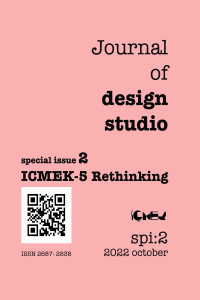Using Video Games for Design Education: An Example of Developing Earthquake Scenarios for Home Environments
Using Video Games for Design Education: An Example of Developing Earthquake Scenarios for Home Environments
The heart of interior design/architecture education is design studios. As a design-based graduate program, the main objective of the International Masters of Interior Architecture and Design Program-(IMIAD) in Istanbul Technical University Graduate School is to produce new disciplinary information and knowledge for design (Cordan, 2017). Additionally, the main objective of the Interior Architecture Project III, which is the third design studio blended with the thesis studies in the IMIAD Programme, is to guide students in their study based on research-based design approach. In this study, one example was presented to explain how the research-based design process conducted. This study was based on developing a game scenario for experiencing earthquakes in an experiential box. The earthquake scenario was developed for a bedroom situation at home environment by using virtual reality and gamification methods. The educational use of video games through serious games helps designers and design students understand real situations and raise public awareness by experiencing them in virtual environments. Besides, the study will fill the gap in the literature by using video games as an educational tool in design to develop scenarios for natural disasters such as earthquakes, the study will help educators for developing new ways of teaching and students for solving design issues using video games. Different scenarios can be developed for different natural disasters and cases in the future for further studies.
Keywords:
Awareness, Design studio, Earthquake Gamification, Video games,
___
- Aman, D. D., Güler, A. C., Ganic Sağlam, N., Tekçe, I., Tunç, H., Hacıhasanoğlu, O. (2022). Disaster Awareness and Education Center-Park Design: Investigation of Outdoor Spaces on Graduation Project of Architecture Students, Journal of Design Studio, spi:1 “Landscape Research”, 19–33.
- Antonietti, A., Cantoia, M. (2000). To See a Painting versus to Walk in a Painting: An Experiment on Sense-making through Virtual Reality, Computers & Education, 34, 213–223.
- Binark, M., Bayraktutan-Sütcü, G., Fidaner, I. B. (2009). Dijital Oyun Rehberi - Oyun Tasarımı, Türler ve Oyuncu. Kalkedon.
- Birer, E. (2022). Critical Reading in Architectural Education, Journal of Design Studio, 4 (1), 21-37.
- Buratti, G., Costa, F., Rossi, M. (2021). An Educational Path on Universal Design. Video Games as Learning Tools. In Ö. Cordan, D. A. Dinçay, Ç. Y. Toker, E. B. Öksüz & S. Semizoğlu (Eds.) Game and Design Education: Proceedings of PUDCAD 2020 (pp. 21-34). Springer.
- Cordan, Ö. (2017). Research-based Design: IMIAD Design Studios, International Journal of Design Education, 11(3), 15-27.
- Garris, R., Ahlers, R., Driskall, J. E. (2002). Games, Motivation and Learning: A Research and Practice Model, Simulation & Gaming, 33(4), 441–467.
- Ozer, P., Çatak, G. (2021). Using Board Games as a Method for Improving Awareness and Empathy in Inclusive Design: PUDCAD Game Case Study. In Ö. Cordan, D. A. Dinçay, Ç. Y. Toker, E. B. Öksüz & S. Semizoğlu (Eds.) Game and Design Education: Proceedings of PUDCAD 2020 (pp. 133-142). Springer.
- Ozer, P. (2020). Using Video Games To Teach Inclusıve Design Principles In Design Education: PUDCAD Case Study [Unpublished master’s thesis]. Bahçeşehir University, İstanbul.
- Price, S., Rogers, Y. (2004). Let’s Get Physical: The Learning Benefits of Interacting in Digitally Augmented Physical Spaces, Computers & Education, 43, 137–151.
- Ritterfeld, U., Weber, R. (2005). Video Games for Entertainment and Education. Playing video games: Motives, responses, and consequences (pp. 399–413). Lawrence Erlbaum Associates Publishers.
- Sardone, N. B., Devlin-Scherer, R. (2016). Let the (Board) Games Begin: Creative Ways to Enhance Teaching and Learning. The Clearing House: A Journal of Educational Strategies, Issues and Ideas, 89(6), 215–222.
- Tekeli, İ., (2014). Mimarlık Eğitimi, Türkiye Yükseköğretim Stratejisi Bağlamında Mimarlık Eğitimi Üzerine Düşünceler, Mobbig 38 Toplantısı Konuşma Metni.
- Tüker, Ç., Çatak, G. (2021). Improving Awareness and Empathy with Video Games: A Qualitative Analysis Study of PUDCAD Game. In Ö. Cordan, D. A. Dinçay, Ç. Y. Toker, E. B. Öksüz & S. Semizoğlu (Eds.) Game and Design Education: Proceedings of PUDCAD 2020 (pp. 121-132). Springer.
- Varinlioğlu, G., Alankuş, G., Aslankan, A., Mura, G. (2019). Dissemination of Digital Heritage through Game Based Learning, METU Journal of the Faculty of Architecture, 36(1), 23-40. http://jfa.arch.metu.edu.tr/archive/0258-5316/articles/metujfa2018209.pdf
- Wrzesien, M., Raya, M. A. (2010). Learning in serious virtual worlds: Evaluation of learning effectiveness and appeal to students in the E-Junior project. Computers & Education, 55(1), 178-187. https://doi.org/10.1016/j.compedu.2010.01.003
- URL-1. Ministry of Interior Disaster and Emergency Management Presidency. (2018, March 5). Afete Hazır Türkiye: Deprem Öncesi, Anı Ve Sonrası Alabileceğiniz Önlemleri Biliyor Musunuz?. Retrieved 26.08.2022, from https://www.afad.gov.tr/deprem-oncesi-ani-ve-sonrasi-alabileceginiz-onlemleri-biliyor-musunuz
- URL-2. AFAD Disaster Statistics (AFAD Afet İstatistikleri), Retrieved 10.06.2022, from https://www.afad.gov.tr/kurumlar/afad.gov.tr/e_Kutuphane/Kurumsal-Raporlar/Afet_Istatistikleri_2020_web.pdf
- URL-3. Earthquake Country Alliance (2022). Retrieved 01.08.2022, from https://www.earthquakecountry.org/library/ECA_Step_1_SecureYourSpace_Document-EN.pdf
- Yayın Aralığı: Yılda 2 Sayı
- Başlangıç: 2019
- Yayıncı: Orhan HACIHASANOĞLU
